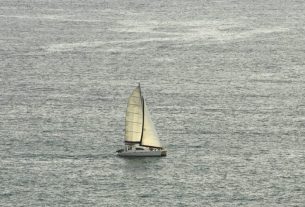It started out as a roots trip, pure and simple. My late maternal grandmother, Elise Rachel Nachmias, daughter of Raphael Nachmias and Blanka Farhi, spent the first 22 years of her life in Bulgaria before being sent to Vienna to marry my grandfather, Czech-born Carl Arenz.
In her later years, after a series of strokes rendered her bedridden, she reverted to speaking Bulgarian, a language I could not understand but which fascinated me almost as much as the stories she told and the food she ate: palachinki (crepes); banitsa (cheese-filled filo pastry); pechen chushki (charred, peeled red peppers).
Each time she came to London (she lived on the coast in Bournemouth), she would drag me to Selfridges department store, where she stocked up on imported items that were hard to get in 1960s England: halva, tehina, figs, dates, and linden honey.
My grandmother was born Christmas Day, 1899, in Vidin – a city on the southern bank of the Danube in northwestern Bulgaria, bordering Serbia and Romania. Her father, a successful paper merchant, also had a home in Ruse (Ruscuk in those days), a Danube city 350 kilometers to the east of Vidin. There, she grew up in the company of her 12 siblings. Most weekends were spent in Sofia, some 300 kilometers from Ruse, where their apartment on Neofit Rilski Street was in the Jewish quarter of the city, a 15-minute walk from the impressive central synagogue.
Traveling to Bulgaria
I book my ticket to Bulgaria and map out the route of my itinerary. My journey would take me in a clockwise direction from the west of the country (Sofia) via the north (Vidin), to the east (Ruse and the Black Sea), and then south (Plovdiv and the mountain ranges of Rila and Pirin), where my grandmother went on day trips from the capital.
I leave Israel on a sweltering morning and arrive in Sofia to a storm that has clearly taken the city by surprise. Locals are still in sandals, cafés have set up tables and chairs outside, awnings have come loose and flap in the wind.
Undeterred, I set out for my first destination – the former Nachmias residence on Neofit Rilski Street. Today, the still-grand building is a luxury office block. I knock at a door on the first floor, hoping to get a sense of the interior of my grandmother’s former home, but the walls of the Visage Modeling Agency are a pristine white, the floor new, and the overall effect soulless. Only the balcony, with its handsome filigree ironwork, remains as it presumably had been in her day.
A university friend who now lives in Sofia, David Mossop, meets me at my hotel later that day and takes me to a restaurant on Hristo Belchev Street called Before and After. The wood-paneled former home of a local poetess, the eatery serves excellent trout, colorful profiteroles, and the best Bulgarian wine in a cavernous salon with discrete recessed niches that look like relics of the communist era. The curious mix of communist-style architecture and formality coupled with Central European grace are to strike me again and again in this decidedly non-modern of countries.
David and I head for the synagogue (the one my grandmother attended) by way of the glorious 16th-century Banya Bashi mosque and gardens. I am out of luck. The synagogue is closed and doesn’t open again for three days.
That night, I go to bed feeling surprisingly light-headed. The electric heater in my room gives off way too little heat, and rainwater has pooled on the window sills and around the stone-cold radiator. I sleep fitfully and wake with a fever. My strenuous roots trip is the last thing in the world I can contemplate.
My second day in Sofia is spent in bed, listening to children splash about in the schoolyard below. Towards evening, the hotel receptionist informs me that it is -2 degrees outside (and quite possibly inside) and that snow is falling in the mountains.
My grandmother was always preoccupied with matters of health. She was a strict vegetarian before anyone in the United Kingdom knew what a salad was, took brisk walks three times a day, aired out her bed linen, wore gloves all year round, and was scrupulous (read obsessive) about hygiene.
What would she have prescribed for me in my feverish state? Plenty of fresh (preferably mountain) air, homemade food, the comforts of a down plumeau (the word I still use for “eiderdown”), long walks, hot baths, tea, and honey with everything.
As my roots trip fades into oblivion, I search my computer for a restorative alternative. Villa Gella pops onto the screen. The place looks like something out of a fairytale: glorious interiors that avoid kitsch but exude comfort; homey, warm, inviting, and magnificently luxurious. Situated in the heart of the Rhodope mountains, in a traditional village, Gella, known for its bears, bagpipes, basilicas, and beauty, the villa appears to offer everything the heart could desire. And more.
A phone call later and I am on my way.
The bus ride to Pamporovo takes four and a half hours from Sofia. From this unspoiled ski resort, it’s a 15-minute taxi ride to Gella. By the time I arrive at the villa, snow is falling on the pines, and the mountains are shrouded in a blanket of white. My hosts are waiting on the doorstep and greet me like a long-lost friend. I’ve arrived in a land of pan-tiled homes and wood-burning stoves, of plum and apple trees, of juniper, oak, and birch, of cows, sheep, goats, and horses, of profound silence, and even more profound hospitality.
VILLA GELLA is not, in fact, a hotel. It is a family estate that hosts individuals, couples, families, friends, and groups. The owner, Ivan, a retired professor of engineering, moved to Gella from industrial Ruse on account of his asthma and hasn’t looked at an inhaler since. He and his spirited wife, Dimka, a former chemist, conceived of Villa Gella as a luxurious mountain retreat – a home away from home. They live there alone, except when guests come to stay. Neither speaks English. For that, they have Darina, Ivan’s charming niece.
I could not have fallen into better or more solicitous hands.
No sooner have I entered the lounge than a beaming Dimka appears from the kitchen with a jug of cloudy red apple juice. The apples, Darina explains, were picked that afternoon. The logs in the enormous grate sizzle and crackle. I feel as if I’ve landed in heaven.
Darina shows me to my room, one of six in the villa, each decorated differently, with a wall of windows that look onto the majestic Rhodope mountains. My bed is enormous. The sheets are made of Egyptian cotton, and the pillows are pure down (my grandmother would most certainly have approved). There’s a walk-in dressing room with a desk fitted into a nook at its end and a sumptuous bathroom from which I can see (and hear) the neighbor’s farm.
I put on the slippers provided and join the family around the fire. Dimka has prepared dinner, and the table is set. The attention to detail is remarkable. I could be in a five-star hotel but happily am not. I’m in a family home that has been lovingly restored, with Ivan’s carpentry on display in the huge oak dining table and lamps (made from recycled beams from the original home on the same spot), and an impressive Liu Dong landscape painting. After several days in Gella, it becomes clear why the painting takes pride of place in the dining room: the mountains in China’s Shaanxi province look remarkably like the Rhodope mountains.
Darina sits down to eat with me. I am hoping that Ivan and Dimka will join us, but Dimka insists on “protocol,” which means serving us course after course of divinely prepared vegetarian food.
Protocol also means starting the meal with the best rakia (Bulgaria’s answer to grappa) I’ve ever tasted; drinking a different outstanding Terra Tangra wine with each course; eating fresh quails’ eggs with my shopska salad (you haven’t eaten shopska salad until you’ve had Dimka’s); savoring baklava topped with rose-petal-infused honey; and being treated with a warmth and courtesy that have long disappeared elsewhere.
Each day, Dimka adds a “surprise” to the protocol. The surprises come in the little (pronounced “leetle”) and big (“beeg”) variety (her classification).
“Today, a leetle surprise for you,” she says on my first morning as she enters the dining room with a bowl of curdling milk which turns into butter in front of my eyes. A little later, she arrives with a platter of palachinki and a bowl of homemade yogurt, honey, and borovinki (blueberry) jam. A third little surprise, delivered that evening, is a tempura of nettle heads which I’d picked that day. Simply delicious.
“Now a beeeeg surprise.” Dimka gestures for me to lie down on the sofa. I do as I am told. She approaches with a plastic bottle of herb-infused rakia, and she massages the 60% proof liquid into my aching body. Then she wraps me in a lambs’ wool shawl and packs me off to bed. By the morning, my fever is but a distant memory.
On the third day, the weather clears a little. I wander out onto the enormous terrace and find Ivan picking the last strawberries from a pot. “Beeeeeeeg surprise” calls Dimka, emerging from the wilds with an enormous mushroom in her hands. The funghi season has apparently arrived. She serves it later, chewy and viscous, with quinoa – her only concession to shop-bought food.
ANOTHER BIG surprise, on my last night in the villa: the appearance of a bagpiper from the neighboring village of Shiroka Laka (home to one of Bulgaria’s two schools of traditional music), who arrives at the end of a wine-fueled dinner (superlative Terra Tangra 2010 Yatrus) and has us all dancing.
So what am I doing when I’m not eating, drinking, and sleeping? I’m doing precisely what my grandmother would have ordered. I am walking in the mountains, taking steam baths, eating home-grown, homemade food (honey included), and being thoroughly spoiled.
The ground floor of Villa Gella, which opens out onto the garden, houses a terrific small indoor pool and steam bath. There’s a deck (useful in summer) with comfy chairs and views to die for. Beyond the deck, and almost out of sight, there’s a petanque (lawn bowls) and a badminton court.
When Ivan spins a shuttlecock in my direction, I feel as if I’ve stumbled onto the set of a BBC period drama.
The Rhodope mountains offer exceptional opportunities for walking. Fortunately, the area has not yet become a tourist destination and the trails are pristine, although badly signed for the most part (it helps to know the Cyrillic alphabet). There are also beautifully appointed mountain huts to sleep in if you feel like going rustic. But be warned – the toilets and showers are outdoors and they’re pretty basic, though each room has its own wood-burning stove and a plentiful supply of logs.
My first jaunt, directly from the villa, is a four-and-a-half kilometer hike up a snow-clad mountain to the Thracian Gradishte fortress. At the 1850 meter summit, Darina produces a thermos of hot tea (St. John’s wort, thyme, mint, mursalski, and oregano that she collected that spring), some home-made pitka bread (like challah), cheese, and chocolate. Ah, Darina – she thinks of everything. We sit on the freezing peak overlooking a landscape dotted with stone houses, pine, elm, and oak forests, soaking up the silence.
THE NEXT day, Darina offers to take me on a three-hour walk (mercifully downhill) to the village of Shiroka Laka, a delightfully picturesque place on a river straddled by two Roman bridges. The walk takes us past an Early-Byzantine basilica on a hill above the villa.
The basilica, part of a religious complex, is the highest in southeast Europe – 1,485 m. above sea level. We cross an enormous meadow where an annual bagpipe festival is held in August and visit St. Elias chapel, borne of a miracle (for you to discover for yourself). The trail is marked and fairly easy, and it takes us through an almost Alpine landscape. We feast on ripe plums and apples picked along the way, drink spring water, and arrive at Shiroka Laka in time for a lunch of white bean stew and tarator (tzatziki) at Kalinas.
There are enough walks around Gella to keep a guest happy for weeks, but I am keen to see a little more of my surroundings before returning to Sofia. After exploring the alleyways of Shiroka Laka, we drive five minutes in the direction of Devin and stumble upon the most intriguing thermal spa. Situated in a tumble-down building on the side of the road, directly opposite the turn-off to the village of Breze, a flag is the only indication that it is anything other than an abandoned farmhouse.
As I approach, I encounter the owner/manager, his dog, and her abundantly happy five puppies. He ushers me into a basic-looking room with three antiquated sun-loungers, and then takes me through a door into a back room, where three corpulent Bulgarians are sitting in silence in a large tub.
They stare at me, and I at them. I understand that the spring water that feeds this spa is at a constant 76 degrees and is especially good for diseases of the musculoskeletal, nervous, and reproductive systems.
Farther along the road is the lively spa town of Devin. A center for healing – the waters (drunk, inhaled, bathed, or swum in) cure every ailment under the sun and are sold bottled throughout the country as “Devin.” The population is a happy mix of Bulgarian Orthodox, Muslim, and Bulgarian-speaking Muslims (Pomak). There’s a great public swimming pool set amid the mountains just outside the town and wonderful walks in the vicinity.
A further 15 minutes down the road, past a few simple Pomak villages, is the impressive Trigrad gorge, which encloses the course of the eponymous river and plunges thunderously into the cavernous Devil’s Throat Cave. Said to be the mythical Hades and large enough to swallow up the entire Alexander Nevsky Cathedral, the cave – according to legend – is the route by which Orpheus (who is said to have been born in none other than Gella!) attempted to retrieve his beloved Euridice.
Trigrad village itself is almost as picturesque as Shiroka Laka, with wonderful walks, horseback riding, and kayaking. I eat fresh trout in the rustic Arkan Han hotel/restaurant and even manage a short stroll in the direction of the Bulgarian-Greek border, a few kilometers away as the crow flies.
RESTORED TO good health, I’m finally ready to embark on the roots trip I came for. But it’s hard to leave Gella. After getting used to the rhythm of country life – eating organic home-grown produce (even the wine, produced by Dimka’s family under the Terra Tangra label, is organic), going to bed at nine and rising with the sun, watching Ivan potter in the garden, drinking mountain tea, taking walks in the fresh snow, picking apples and plums, and being massaged before bed – the prospect of driving through the country looking for vestiges of my family history is less appealing.
I came to Bulgaria to learn something about my grandmother’s early years, and in Gella I discovered the essence of what she so loved and missed about her homeland when she moved first to Vienna and then to England.
She missed the fresh food of her childhood, the vitality and warmth of her friends, the mountain walks and fresh air, her language, and a life without convenience foods, in the bosom of her family, enjoying traditions and customs passed down the generations.
In a diary entry for October 4, 1913, my grandmother wrote about a day out in Vitosha, a mountain range just south of Sofia. She’s excited because the Meshulam family has a car, and she’d never ridden in a private vehicle. They pack fresh bread (pan, as she writes in Judeo-Spanish), cheese, apples and pears, some cookies, and water (agua).
They walk to a hut, play hide and seek, eat their picnic, and admire the view. She takes out her diary and pens a few words in German to her father who is traveling on business in Greece. “Dear Daddy,” she writes, “We’re in Vitosha and the weather is still warm, but a little cloudy. Fraülein Steffi [the governess] is teaching us new words in German and promises us sladoled [ice cream – the Bulgarian word this time] when we get home. I miss you.”
My diary entry for October 4, 2022, isn’t much different. A century plus apart and we’re in the same country, just a mountain range apart, doing the same thing, thinking similar thoughts, and feasting our eyes on a vista unchanged in centuries.
In Gellam, I have unwittingly discovered my roots.
Facts
- Villa Gella houses up to 12 guests in six glorious bedrooms all with en-suite bathrooms. You can book as an individual or as a group. Exclusive use of the property for a week (available year-round) costs around NIS 40,000. The price includes fabulous home-cooked vegetarian meals and equally stunning wines and the warmest hosts you’ll ever encounter. The villa is located two and a half to four and a half hours from Sofia, depending on how you travel and the route you take. The nearest airport is Plovdiv, which is around one hour and thirty minutes from the house. The villa can also be easily reached by car from Istanbul and Thessaloniki, by helicopter from Sofia, or for the more adventurous by horseback!
- Villa Gella, Gella, Rhodope mountains: www.villagella.com; email: [email protected]
- El Al flies three times a week from Tel Aviv to Sofia, from $400.
- Finding a Bulgarian grandmother is a little harder.



